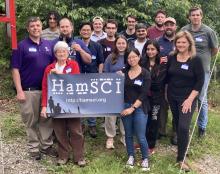HamSCI Field trip to Jenny Jump NJ
HamSCI Field trip to Jenny Jump NJ

A large HamSCI-led team recently made a field trip to Jenny Jump State Forest (NJ), surveying the United Astronomy Clubs of New Jersey (UACNJ) site. It is located on a rustic, park-like property, where the UACNJ hosts scientific instruments from many US-based institutions, including the New Jersey Institute of Technology (NJIT) and HamSCI. The trip’s primary goals:
1) Assess maintenance needs of the existing Personal Space Weather Station (PSWS) equipment
2) Develop a plan for upgrading to the current generation of PSWS (DASI Track 2)
The findings were mostly positive: The HF receive antennas (a DXEngineering active vertical and a DXE receive loop) are generally in good condition, though animals have done some damage to cabling. The Reverse Beacon Network (RBN) receiver is currently off-line, in need of attention.
As for the PSWS/DASI2 upgrade, plans were made for summer ‘work parties’ to replace computers, install an RX888-based WSPRDaemon GRAPE receiver, re-site the HamSCI ground magnetometer, and install a new VLF receiver/signal processor. Additionally, the RBN Rx will be brought back on-line and cables repaired as needed. Much of the work will be done by members of the amateur radio clubs from NJIT (K2MFF) and the University of Scranton (W3USR).
The trio of PSWS instruments (GRAPE Rx, VLF Rx and magnetometer) represents the next generation of PSWS. It will be one of approximately 30 such systems to be deployed in 2025/2026. Collectively, the systems will form a space weather data collection network, the first of its kind to simultaneously monitor HF (shortwave), VLF (~8 kHz) and the Earth’s magnetic field. Using data collected by the Network, HamSCI researchers hope to gain a better understanding of the local, regional, and global scale processes that influence the ionosphere. This may lead to improved propagation predictions, new tools to predict radio wave behavior during solar storms, and, perhaps, new insights regarding solar cycles and other heliophysical phenomena.
All efforts at this site, from planning to equipment construction, configuration and installation is a collaboration between the University of Scranton and NJIT. Conveniently, the site is located exactly halfway between the two schools. Beyond station implementation, the schools partner on data collection, data analysis and research efforts.
Photos courtesy of Ann Marie Rogalcheck-Frissell and Nathaniel Frissell
